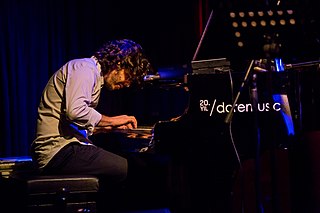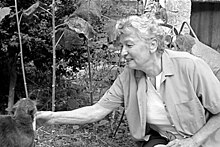
Augusta Read Thomas is an American composer and professor.
Michael Blake is a South African contemporary classical music composer and performer. He studied in Johannesburg in the 1970s and was associated with conceptual art and the emergence of an indigenous experimental music aesthetic. In 1976 he embarked on 'African Journal', a series of pieces for Western instruments that drew on his studies of traditional African music and aesthetics, which continued to expand during two decades in London until he returned to South Africa in 1998. From around 2000 African music becomes less explicit on the surface of his compositions, but elements of rhythm and repetition remain as part of a more postcolonial engagement with material and form. He works in a range of styles including minimalism and collage, and now also forages for source material from the entire musical canon.
Sean Hickey is an American composer and record label executive, born in 1970 in Detroit, Michigan, and currently based in New York. In 2022, he was appointed Managing Director of Pentatone.
The Nash Ensemble of London is an English chamber ensemble. It was founded by Artistic Director Amelia Freedman and Rodney Slatford in 1964, while they were students at the Royal Academy of Music, and was named after the Nash Terraces around the academy. The Ensemble has won awards from the Edinburgh Festival Critics and the Royal Philharmonic Society, as well as a 2002 Gramophone Award for contemporary music.

Lior Navok is an Israeli classical composer, conductor and pianist. He was born in Tel Aviv. His music has been performed internationally by orchestras and ensembles including the Oper Frankfurt, Nuernberg Opera, Israel Philharmonic Orchestra, Boston Modern Orchestra Project, and the Tanglewood Festival Orchestra. Amongst the awards he has received are those from the Israel Cultural Excellence Foundation and the Massachusetts Cultural Council. He has also received awards from the Fromm Music Foundation, Lili Boulanger Memorial Fund Award, and Israel Prime Minister Award. In 2004, he was one of seven composers awarded commissions for new musical works by the Serge Koussevitzky Foundation in the Library of Congress and the Koussevitzky Music Foundation.
Zdeněk Lukáš was a Czech composer. He authored over 330 works.
The Melos Ensemble is a group of musicians who started in 1950 in London to play chamber music in mixed instrumentation of string instruments, wind instruments and others. Benjamin Britten composed the chamber music for his War Requiem for the Melos Ensemble and conducted the group in the first performance in Coventry.
Gary Alan Kulesha is a Canadian composer, pianist, conductor, and educator. Since 1995, he has been Composer Advisor to the Toronto Symphony Orchestra. He has been Composer-in-Residence with the Kitchener-Waterloo Symphony (1988–1992) and the Canadian Opera Company (1993–1995). He was awarded the National Arts Centre Orchestra Composer Award in 2002.
In music, a decet—sometimes dectet, decimette, or even tentet—is a composition that requires ten musicians for a performance, or a musical group that consists of ten people. The corresponding German word is Dezett, the French is dixtuor. Unlike some other musical ensembles such as the string quartet, there is no established or standard set of instruments in a decet.
Marti Epstein is an American composer. She is Professor of Composition at Berklee College of Music and the Boston Conservatory at Berklee.
Jan Tausinger was a Romania-born ethnic Czech violist, conductor and composer.

Evrim Demirel is a Turkish composer and jazz pianist.
Marc-André Dalbavie is a French composer. He had his first music lessons at age 6. He attended the Conservatoire de Paris, where he studied composition with Marius Constant and orchestration with Pierre Boulez. In 1985 he joined the research department of IRCAM where he studied digital synthesis, computer assisted composition and spectral analysis. In the early 1990s he moved to Berlin. Currently he lives in the town of St. Cyprien and teaches orchestration at the Conservatoire de Paris.

Suzanne Giraud is a French music educator and composer of contemporary music. Her works are marked by a predilection for percussion, voices and strings; they resonate with her artistic, poetic and architectural inspirations.

Janet Maguire is an American composer who was born in Chicago and resides in Venice, Italy.
Eibhlis Farrell is a Northern Irish composer.
Rhodri Davies is a harp player working within the field of free improvisation. He was one of the most prominent members of the London reductionist school of improvised music that was active in the late 1990s and early 2000s and which has been described as being "extremely influential over the last decade".
Angharad Davies is a Welsh violinist and composer, known for her work in the field of free improvisation, her use of prepared violin, her extensive discography and collaborative work with other musicians.





